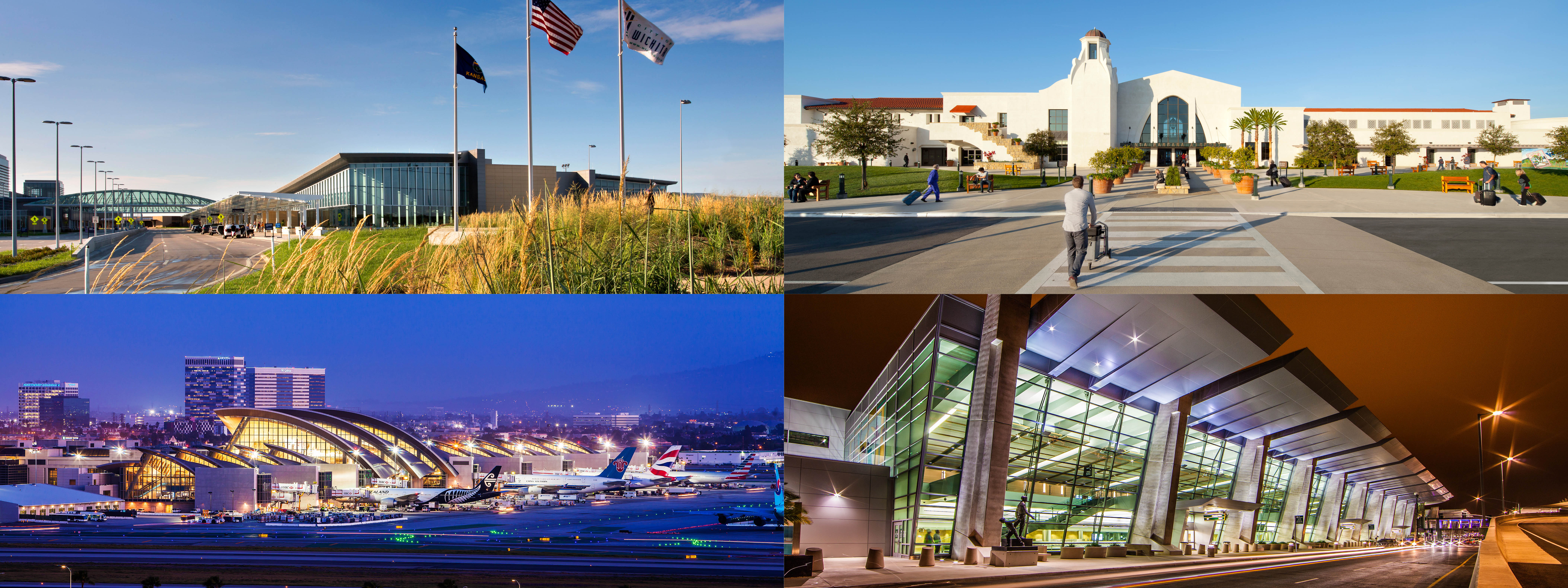
Excellence in Airport Design: Terminal Replacement Strategy
Terminal replacement projects require architects and engineers to work collaboratively with airport clients and airline and concessions tenants to accomplish a finished product that is functional and aesthetically desired. A successful terminal replacement captures the personality of the destination city while maintaining, and even enhancing, the airport’s brand. A replacement terminal should satisfy tenant needs by integrating their branding and the newest state-of-the-art technology from a contactless ticketing experience, to ease of airport use and access by both employees and passengers. Replacement terminal designs need to consider the original terminal’s location and existing infrastructure, such as utilities, materials, and landside and airside access, in order to integrate seamlessly back into the same environment.
Terminal Replacement: Our Southern California Expertise In Action
San Diego International Airport
One of the biggest challenges operators and airport design teams face is the requirement that the existing terminal needs to be fully operational throughout construction. This involves working around existing infrastructure, including landside roadways, parking, airside taxiways, and the airport apron, while terminal construction is underway. It also means causing as little interruption or impact as possible to passenger flow, airport capacity, and flight schedule.
During the Terminal 2 West design-build project at San Diego International Airport, HNTB worked with Turner Construction to meet a tight design and construction schedule while keeping the final product under budget and maintaining a fully operational airport. The design, completed under these limiting constraints, also achieved the first LEED Platinum recognition for an aviation facility in the United States.
Los Angeles International Airport, Terminal One East and Utility Master Plan
This terminal required the design team to consider not only Southwest Airlines’ specific parking requirements, but also the FAA regulations and NFPA 415 standards that protect life and property from fire in airport terminal complexes.
Collaboration was critical between the architects designing the terminals and airfield civil engineers designing the ramps, to be able to develop a finished floor that worked with the surrounding topography and minimized earthwork at the site. Also, we needed to address aircraft parking, passenger access to the aircraft, utilization of boarding bridges or fixed walkways, door locations, GSE tug routes, service road access, and where fueling operations take place.
A challenge associated with replacement terminals that may be overlooked is the capacity for utilities. Electrical power, water, sewer, and the Central Utility Plant need to be considered. What does the surrounding existing utility infrastructure offer and what will need to be augmented or adjusted? For the LAX project, we did a comprehensive Utility Master Plan, taking into consideration existing infrastructure and future master improvements.
Santa Barbara Historic Terminal Relocation and Replacement
For the Santa Barbara Airport Historic Terminal Relocation and Renovation project, HNTB restored the wearing condition of the facilities and to replace and relocate the main terminal. This required reconfiguration of the site, the addition of short and long-term parking lots with ticketing gates and required dedicated public transit lanes for passenger drop-off and pick up. Relocating the original terminal had its challenges: the terminal was sectioned into three parts, lifted off the foundation, moved, and then reassembled in the new location. The historic terminal was preserved, and it is now an aviation museum.
The collaborative design process involved community engagement and involvement through more than 50 public workshops and presentations at every stakeholder level, from city agencies and community groups to the FAA, the airlines, and the TSA. The new terminal accommodates 75,000 passengers annually and preserves the history and character of the community.
Designing for the Future of Aviation
As replacement terminals are designed, they require flexibility and expandability for future airport development. Looking at the projected needs of an airport 15-20 years in the future informs the design of the replacement terminal and airfield. Understanding evolving circumstances, changing traffic patterns and opportunities for employing new technologies helps us design with maximum flexibility and seamless expandability, while maintaining an economical design for the airport owner now and into the future.
Hear from HNTB's aviation experts about designing replacement terminals.
Learn more about our work with the country's major airports by clicking here.
